Queen of Angels Read online
Page 2
The door knew him. With a polite nod to its heavy wood face, Richard entered and was absorbed into a great commonality of the untherapied. Fourteen of Madame de Roche’s faithful pooled around the stairs, their slippers padding or hard plastic soles tapping on the cool red granite floor: three young long-haired collegiate women admiring an early Shilbrage in an alcove; two tuxedoed men discussing sharp trade transactions in the shadows banks; a ring of four denimed poets admiring each other’s hand printed broadsides. Dressed their best except where philosophy demanded less they cradled drinks in mannered fingers and nodded as he passed; Richard was not senior, not this month. + Friends but would not lift a digit if I fell. Petronius would know them. Lord spare me they’re all I have or deserve.
In a chair away from this spreading pool sat Madame’s appointed favorite this month, Leslie Verdugo of ancient family, a lovely white haired wraith whom Richard had never addressed out of shyness perhaps but more probably because she smiled all the time, ether-seeing, and this did not attract him. Sitting across a glass topped occasional table from her was Geraldo Francisco a New Yorker who specialized in printmaking using ancient methods. Approaching them diffidently was Raymond Cathcart who called himself an ecologist and wrote poetry that occasionally stirred Richard but more often bored him. Breaking away from the poets to join this new attractor was Siobhan Edumbraga, an exotic female in speech and manner but clumsy in all physical acts and occasionally sharply rude, an innocent of no talents he could discern. She had made up her name; he did not know her real name.
Richard found his place in the ring of poets and leaned over them, somber eagle face and liquid gray eyes betraying no eagerness, biding patiently. News of some late progressive insult to the arts nano or another outraging medium compelled them all to laugh, full of hate and envy. Resources of the combs made them look like children playing with Plasticine. They were individualists and they cherished their untherapied dishonesties or skewed perceptions; they thought natural blemishes necessary to art. Richard shared this belief but did not take it seriously. There was after all the majesty of accomplishment in the combs compared to a clutch of illmannered broadsides in the sweaty hands of low poets. + To love one’s self is to be therapied. Self-hatred is freedom.
“Richard’s not often so late in line,” said Nadine coming out of nowhere outside the circle and behind him, dressed in red. Nadine Preston was his age but only recently escaped by messy divorce from the privileges of the combs. Her smooth face and black hair wreathed a lovely child’s smile. He saw her slender body in flash memory. Sweet three quarters and one quarter mascaraed harpy. When sweet she was his last sexual solace, but Richard did not stay for her tantrums.
“I have had an adventure,” he said softly, gray eyebrows raised.
“Oh?” Nadine urged but the ring was not having it; their conversation rivered on.
+ Was this Nemesis, come to balance my books? Good line.
“Emanuel Goldsmith is missing,” he said deep voice still soft but clearly audible. “He is being sought by the LAPD.”
The poets turned their heads. He had seconds to hook them fast. “The public defenders spoke with me about him,” Richard said. “Eight people were murdered two nights ago. I came to Emanuel’s apartment in the third foot of East Comb One. The lift was blocked and pd were there and all manner of arbeiters. The room was being frozen. The most stunning—”
Madame de Roche came down the stairs in a quick saintly glide, blue chiffon trailing, red hair gentle on her shoulders. Richard paused and smiled showing his large uneven teeth.
“Such a lovely group,” she greeted, beaming. Without apparent discrimination she fixed her faithful with sapphire eyes wrapped in naturally acquired wrinkles in that motherly face, features arranged to show good humor and loving sympathy though she did not actually smile. “Always a pleasure. Pardon my lateness. Do go on.”
Nadine said, “Richard has been at the scene of a crime.”
“Really?” Madame de Roche said at the bottom, ivory hand on ebony wooden ball. Leslie Verdugo joined her and Madame beamed briefly on her then turned all attention to Richard.
“I was interrogated by the most stunning woman a pd in uniform, black as jet but not negroid. I think at first she wanted to accuse me of the crime, or at least of public recklessness for not turning Emanuel in. I wondered: was this Nemesis, come to balance my books?”
“Do start again,” Madame de Roche said. “I believe I’ve missed something.”
No pain, no gain. World’s a rough. All we learn comes of our own sharp go. We torment each other. Race is like acid in a tight metal groove; we etch. Hope?
3
In a lost time of myth the coast of southern California had been littoral brown and dusty desert populated by Indians Spaniards mestizos scrub and ancient twisted pines. Now from twenty kilometers below Big Sur to the tip of Baja it was a rambling ribbon of community linked by slaveways, fed by desalting plants and mountain melts gathered from as far as Canada, punctuated by the towers of Santa Barbara the immense diurnal mirrored combs of Los Angeles centipede segments of South Coast monuments and the sprawling rounded ceramic arches and spires of San Diego. Nestled between the desalting and fusion plants of San Onofre and San Diego, like islands in this coastal and inland battle of titans lurked the groundling enclaves of La Jolla and Del Mar, blanketed in shabby gentility and celebrated memory of years past.
Flanking the sprawl of the University of California at San Diego, these cities boasted hundreds of thousands of atavists who wished to live lives of past simplicity. The once ubiquitous doctors and lawyers and heads of corporations had decades before abandoned their beachside palaces to move into the central luxuries of the monuments; outmoded academics and scholars took their place.
Her Professor Doctor Martin Burke, O.V.F. & I.—Once Very Famous and Influential—had recently left the monuments and the bosom of highrise society to slum in the flatlands. He had found himself an old not ruinously expensive apartment in the inland hills of La Jolla and here he sat with barely enough energy to answer his chiming phone, trying to raise some enthusiasm for a scheduled public broadcast of the latest LitVid 21 AXIS report, history in the making.
He turned down the sound on the floating head and shoulders of an announcer and reached out on the third chime to make sure the phone’s vid was off. Then he said, “I’ll take it.” The phone opened a connection. “Hello.” Martin’s voice was hoarse and phlegmy. He sounded sixty; he had just earned forty five.
“Martin Burke, please.” A pleasant, aggressive male voice.
He coughed. “Speaking.”
“Mr. Burke, you used to work for the Institute for Psychological Research—”
“Used to.” Pause. Sounded like a journalist. “I had nothing to do with—”
“No, of course not. My name is Paul Lascal, Mr. Burke. I’m not a reporter and I’m not interested in the Raphkind scandals. I am interested in what you know about IPR. Would it be possible to speak with you soon?”
A LitVid simulation of AXIS itself floated before him, narration muted. The craft’s deceleration vanes were shown spread wide a spidery thing of deep space. The vanes withdrew with unreal speed and AXIS’s children flushed like a thousand handsful of nickels smeared by gravity in a gray pointillistic curve around the second planet of Alpha Centauri B.
“The last thing I want to talk about is IPR,” Martin said. “Where did you get my number?”
“I represent Mr. Thomas Albigoni.” Lascal paused for some sign of recognition, then continued smoothly without it. “Carol Neuman gave him your name and phone number. She thought you might be able to help him.”
“I don’t see how. I haven’t worked at IPR for a year. How is Carol connected with Mr. Albigensi—”
“Albigoni. Thomas. Mister. She was a therapist for his daughter. They became friends. I understand you’re no longer in the silky with the regulators. That could make you doubly useful to us. Just a short talk. Say, over lunch?”<
br />
Martin looked at the mess in his small kitchen. He had not mustered the energy to tell the apartment arbeiters to clean it up. He had not eaten since early evening of the day before. “You seem to think I should know who Albigoni is.”
“He’s a publisher.”
“Oh? LitVids?”
“And books,” Lascal said pointedly. “Far more lit than vid.”
“Is he after an exposé?”
“No. Another matter entirely.”
Martin rubbed his nose. “In that case, and considering it’s Carol, maybe I’ll accept.”
“Do you know—” Lascal named a shoreline La Jolla restaurant, very expensive.
“I know it.”
“About one hour from now? Just ask for Mr. Albigoni’s table.”
Martin gave an assenting grunt and put the receiver down. He leaned back in the weak cushions of his aging armchair. On the battered coffee table sat a ceremonial and condensed printed copy of his twenty year old atlas of the human brain, a seminal work from his salad days. Sometime during the previous night he had drunkenly opened it to a plate of the olfactory nerve and system. Next to the plate he had drawn a crude cartoon of a vampire, teeth trickling teardrops of blood, with branching arrows connecting cartoon and pink and white cauliflower flesh of prepyriform cortex, olfactory bulb and rhinencephalon.
From the armchair he could see into the apartment’s small bedroom. In one corner beyond the bed a tall metal case supported stacked cubes of data. Martin’s life had centered on those cubes until President Raphkind’s downfall and suicide had ushered in the new era of constitutional cleansing and investigations. He had not been part of the Raphkind scandals—not directly—but his research had been targeted. Federal had shut down IPR and tucked him away from his true calling.
He turned up the sound on the AXIS report pushed himself forcibly from the armchair and walked into the bathroom to shave and dress.
Martin had once hiked the Country of the Mind. Now he was reduced to accepting luncheon dates with curious strangers just to get out of the apartment.
Why put on eyeglasses? Why look out and ahead? You won’t go there, I won’t. We are all Moses staring into Canaan. Who in hell cares if our children get there? My this has been a bitchy evening, hasn’t it?
4
LitVid 21 (Science and Philosophy Nets) Scheduling 12/23/47
1: AXIS MultiNet Coverage 24 hr reports four tiers
A Net: PubAcc David Shine and Team
B Net: PubAcc Direct Data Downlink (Hobby-Tech)
C Net: Australian Squinfo: Analysis (Pay)
D Net: Lunar Squinfo: Analysis (Pay)
2: Designer Babies Conference Tucson AZ 0800-2200 (Member Conference Pay)
A Net: Health and public acceptance
B Net: Future social change
C Net: Religious, Historical and Scientific Images of Humanity
3: Public Science Issues Forum PubAcc MultiNet 0900-2100
A Net: Diane Muldrow-Lewis-Taper Playback Interviews with Science/Tech Pers. (Expanded Schedule for subjects)
B Net: Senate Transform Law Debates Discrimination in Eastern States?
C Net: Arbeiter Design Conference Cleveland, Ohio
D NET: NANOTECH NEWS (Chosen for Recording, $20.00 Fee)
E Net: END SELECTION
Selection made: 1/AXIS Multinet A Net B Net switch at will No fee
LitVid 21/1 A Net (David Shine): “AXIS has been on the road for fifteen years, at a cost of over one hundred billion dollars, a lot of treasure for such a distant piece of metallic fluff many have said. But the overwhelming voice of the world community spoke loud and clear three decades ago, and it said Yes. AXIS, an acronym for Automated eXplorer of Interstellar Space, became the grandest project in recent history, perhaps more important overall than the manned Mars missions, the return to the moon, the orbital platforms and stations…For in planning, building and launching AXIS the world propelled itself deliberately and with historically unprecedented foresight into a new industrial revolution.
“The technologies necessary for AXIS’s success—the nanotechnologies of machines smaller than living cells—have already changed our lives and promise much more in the very near future. But which is more important, the economic and industrial benefits, or the philosophical and psychological?
“Through AXIS we might find our doppelgangers, our soulmates; we might find mankind’s future husbands and wives among the angels who the Bible tells us once cohabited with Earthlings.
“AXIS may be therapy for us all, for the great uncured, unhealed human race, with so far to go on its breathless course through history. We may finally be able to compare ourselves to our superiors, or our equals, and know where we stand.
“As for yourself, you’ll find more formal telecasts on other LitVid 21 channels. We are taking the universal feed and simulated report from Australian and lunar farside mission control, and adding our own cultural spin.
“In the past few weeks, AXIS has returned images of three planets circling Alpha Centauri B. As yet these worlds have not been named, and are called only B-1, B-2, and B-3. B-3 was already known to moonbased astronomers; it is a huge gas giant some ten times larger than Jupiter in our own solar system. Like Saturn it is surrounded by a thin rugged ring of icy moonlets. B-l is a barren rock hugging close to Alpha Centauri B, similar to Mercury. But the focus of our attention is now on B-2, a just-right world slightly smaller than Earth. B-2 possesses an atmosphere closely approximating Earth’s, as well as continents and oceans of liquid water. It is orbited by two moons each about a thousand kilometers in diameter.
“AXIS’s sensors and telescopes discovered B-2 almost three years ago. Now AXIS is making its move on this Earthlike world. That is, it made its move over four years ago, for AXIS is sending us information at the speed of light across four light years. The signal has been relayed by fifty transponders across almost forty trillion kilometers of empty space. The reports are only reaching us this week, in compressed form, to be decoded, enhanced and analyzed by thinking machines in California and by planetary scientists around the world.
“This is as close to live and realtime as God allows us to be.”
Switch/LitVid 21/1 B Net (Decoded: Australian Cape Control: Message relayed Space Tracking: Lunar Control: Australian Cape Control: AXIS Mind Team Leader Roger Atkins)
(! = realtime)
AXIS (Biologic Band 4)> Hello, Roger. I assume you’re still there. This distance is a challenge even for me, based as I am upon human templates…(politeness algorithm diagnosis for total mechanical-biologic thinker function V-optimal) most of the time. I have come within a million kilometers of B-2 mark this moment 7-23-2043-1205:15. I am preparing my machine and bio memories for receipt of information from the children, now flying in a perfectly dispersing cloud toward B-2. Data on B-3 have been relayed. The planet, you can see, is quite Jovian, very pretty, though tending toward the greens and yellows rather than reds and browns. I’m enjoying the extra energy from B’s light; it allows me to get some work done that I’ve been delaying for some time, opening up regions of memory and thought I’ve closed down during the cold and dark. I’ve just completed a self analysis; as you doubtless have discovered by checking my politeness algorithm diagnostic, I am V-optimal. I am not using the formal “I” the joke about self awareness still does not make any sense to me.
(Total algorithm diagnostic time: 4.05 picoseconds)
Sensations:
My temperature is 276 K. Radiation flux .82 solar unity. My optics are warming nicely; bioptics should be fully grown and ready for electronic interface within 21 hours. My final biological extensions are also growing nicely; nutrients have not degraded and I can expect to begin integrating new neural extensions and checking their fitness within the hour.
I assume my earthbound twin is interpreting these bursts adequately, politely, suavely.
!JILL Roger: how is it?
!Roger Atkins Just fine.
(Redundancy
and Oliphant code checks complete) AXIS (Biologic Band 4) Non-neural systems report they are ready to download the last six months’ worth of information on C.
Enough burst chatter. As you can see, I am healthy. Expect next burst assembly diagnostics from non-biologic systems.
(Burst routed to machine language division: machine computation V-optimal)
!Roger Atkins Alan, AXIS is doing just fine. Jill’s simulation is a perfect match. Routing to machine language division.
LitVid 21/1 B Net (Recorded Interview AXIS Space System Project Manager Alexander Tranh): “Biologicals and integration team reports AXIS is in prime condition. We are about to receive information that AXIS’s sensors have been gathering over the last half year of flight toward B-2. The large portion of this information will concern Alpha Centauri C, commonly called Proxima Centauri. As most of our viewers should know by now, astronomers are very interested in Proxima Centauri, even though it lies some one trillion miles from the A and B components of Alpha Centauri. C is a very small star indeed, one of the five smallest stars currently known, less than one-tenth the mass of our sun and less than half the diameter of the planet Jupiter. It is very like the class of red dwarf stars named after UV Ceti, flare stars that brighten and dim over a period of days.
“Information about A and B is currently decoded and available worldwide on the Australia/Squinfo subscription service, proceeds from which, of course, go to pay for future analysis of AXIS data.”

 Foundation and Chaos
Foundation and Chaos Halo: Silentium
Halo: Silentium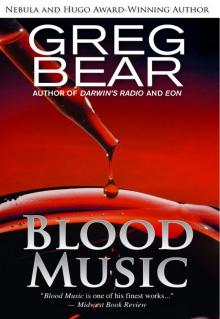 Blood Music
Blood Music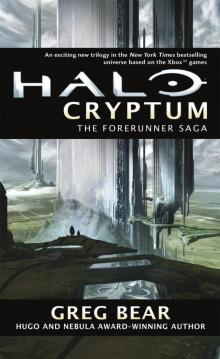 Halo: Cryptum
Halo: Cryptum Halo: Primordium
Halo: Primordium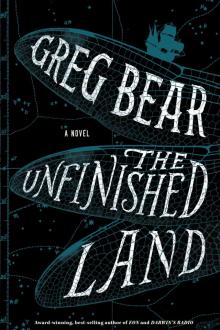 The Unfinished Land
The Unfinished Land Hardfought
Hardfought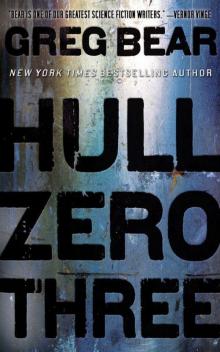 Hull Zero Three
Hull Zero Three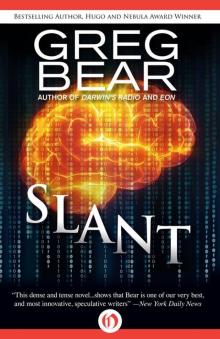 Slant
Slant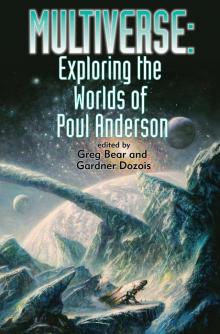 Multiverse: Exploring the Worlds of Poul Anderson
Multiverse: Exploring the Worlds of Poul Anderson Take Back the Sky
Take Back the Sky Nebula Awards Showcase 2015
Nebula Awards Showcase 2015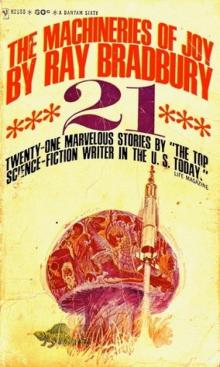 Machineries Of Joy
Machineries Of Joy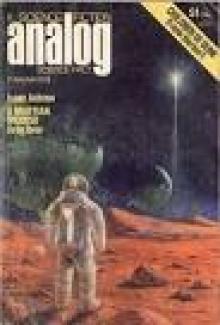 A Martian Ricorso
A Martian Ricorso Eternity
Eternity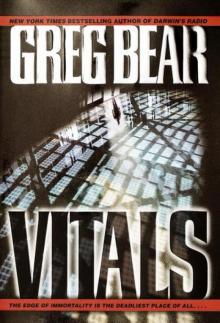 Vitals
Vitals The Infinity Concerto
The Infinity Concerto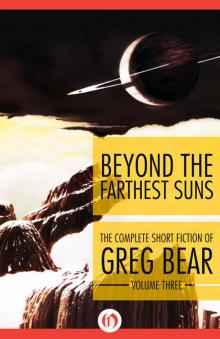 Beyond the Farthest Suns
Beyond the Farthest Suns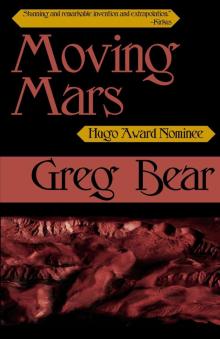 Moving Mars
Moving Mars Quantico
Quantico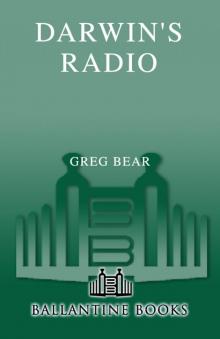 Darwin's Radio
Darwin's Radio Beyond Heaven's River
Beyond Heaven's River Star Wars - Rogue Planet
Star Wars - Rogue Planet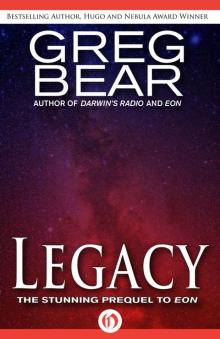 Legacy (Eon, 1)
Legacy (Eon, 1) War Dogs: Ares Rising
War Dogs: Ares Rising Sisters
Sisters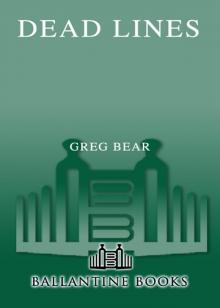 Dead Lines
Dead Lines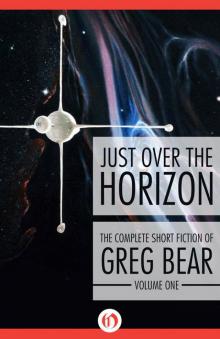 Just Over the Horizon (The Complete Short Fiction of Greg Bear Book 1)
Just Over the Horizon (The Complete Short Fiction of Greg Bear Book 1)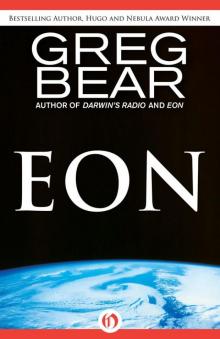 Eon (Eon, 2)
Eon (Eon, 2)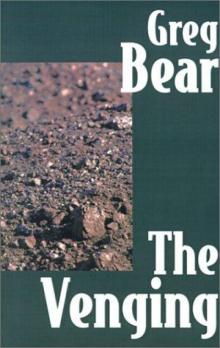 Venging
Venging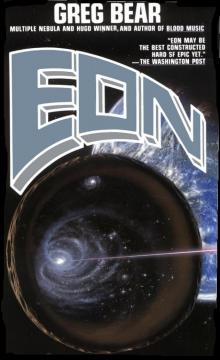 Eon
Eon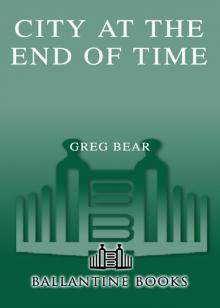 City at the End of Time
City at the End of Time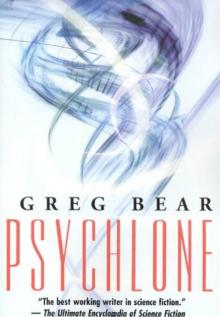 Psychlone
Psychlone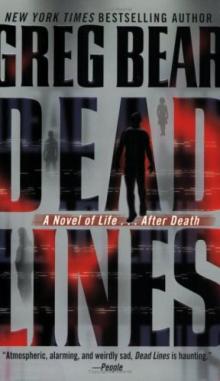 Dead Lines, A Novel of Life... After Death
Dead Lines, A Novel of Life... After Death Eternity (Eon, 3)
Eternity (Eon, 3) Cryptum
Cryptum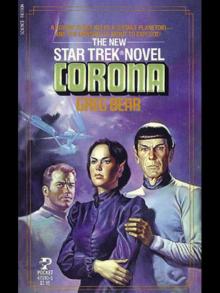 Corona
Corona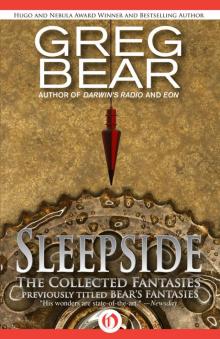 Sleepside: The Collected Fantasies
Sleepside: The Collected Fantasies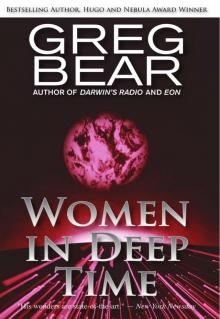 Women in Deep Time
Women in Deep Time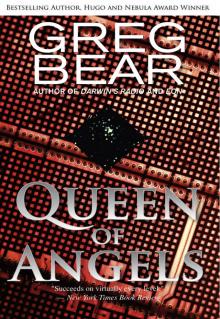 Queen of Angels
Queen of Angels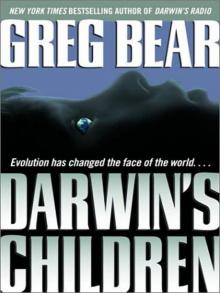 Darwin's Children
Darwin's Children Dinosaur Summer
Dinosaur Summer The Forge of God tfog-1
The Forge of God tfog-1 Foundation and Chaos f-9
Foundation and Chaos f-9 Star Wars: Rogue Planet
Star Wars: Rogue Planet The Forge of God
The Forge of God Mariposa
Mariposa Halo: Cryptum: Book One of the Forerunner Saga
Halo: Cryptum: Book One of the Forerunner Saga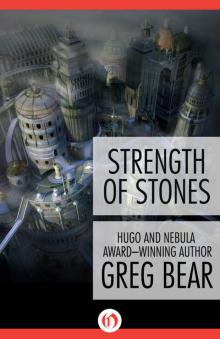 Strength of Stones
Strength of Stones Anvil of Stars
Anvil of Stars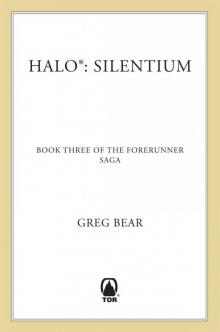 B00AQUQDQO EBOK
B00AQUQDQO EBOK Anvil of Stars tfog-2
Anvil of Stars tfog-2 Ares Rising 1: War Dogs
Ares Rising 1: War Dogs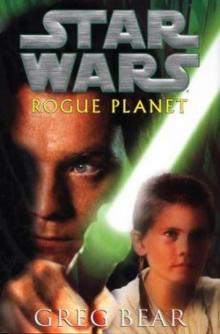 Rogue Planet (star wars)
Rogue Planet (star wars) The Machineries of Joy
The Machineries of Joy Far Thoughts and Pale Gods
Far Thoughts and Pale Gods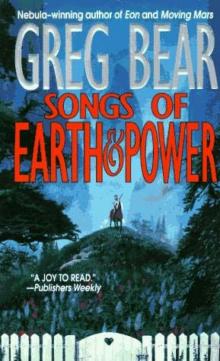 Songs of Earth and Power Omnibus
Songs of Earth and Power Omnibus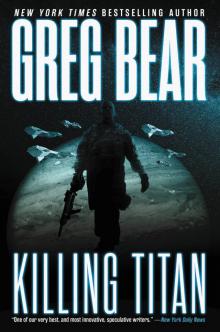 Killing Titan
Killing Titan Darwin's Radio d-1
Darwin's Radio d-1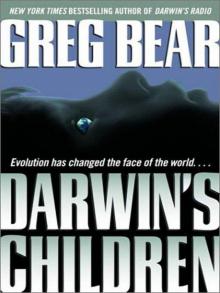 Darwin's Children d-2
Darwin's Children d-2